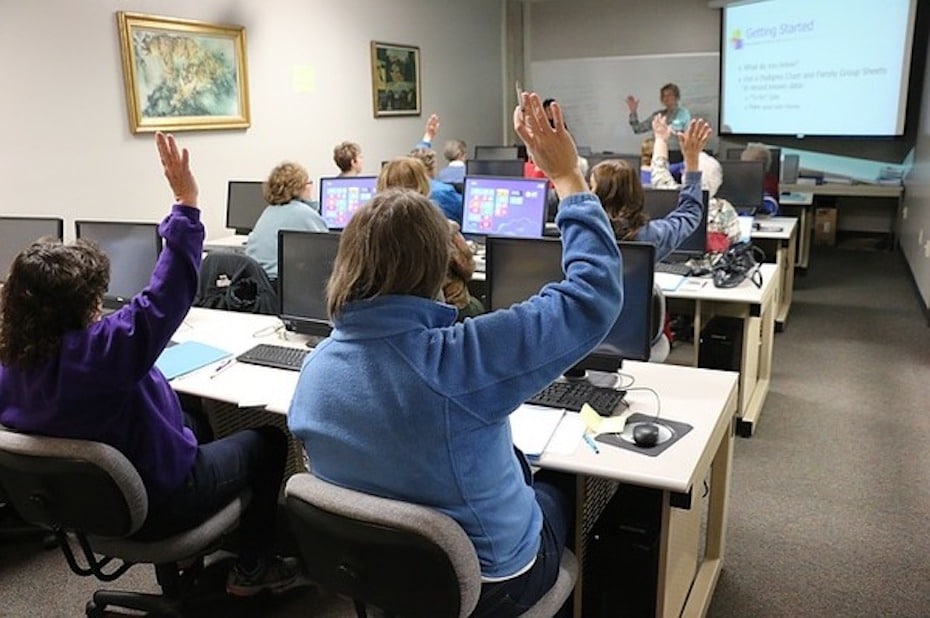Highlights:
- AI technologies are revolutionizing the education sector, with multiple applications that support students and teachers.
- Advances in AI are enabling personalized education, a concept that educators and students are eager to embrace.
- AI can reduce many of the time-intensive, manual tasks educators must perform, including grading.
👩🏫 💻 📚 Need a refresher on virtual learning best practices? Grab our eBook for tips, techniques, and tools.
The shift to more online learning during the COVID-19 pandemic allowed educators to explore more digital tools, including those that employ artificial intelligence. Many diverse possibilities exist for how AI fits into the educational landscape.
How AI fits into education
According to Research and Markets, the compound annual growth rate for the AI education market from 2018 through 2022 is 47.7 percent. The following is a look at some of the ways in which AI fits into education, along with insights on potential learning outcomes.
Personalized education
Educators have long wished they had the time and resources to teach learners at their own pace. However, typical student-to-teacher ratios do not allow for such a high level of customization. Artificial intelligence offers a gateway to move closer to that objective.
The evolution of AI was significant during COVID-19 as educators adapted to home-based digital learning. Implementation of online learning included the use of various AI tools. This integration gives teachers the ability to offer extra resources and give students the capacity to take on extra activities or to move ahead.
Student support
One of the ways educators personalize the student experience is via AI support. In particular, chatbots allow students struggling with concepts to gain access to assistance 24/7.
AI chatbots have been common in retail for several years. Its use in retail is relatively new, though. AI bots recognize common questions or terms that students bring up in the chat. When possible, the bot gives the students an answer or directs them to an online resource with more information.
The chatbot may not have answers to all student problems, but it can tackle a good portion of them. Not only do students get help when they need it, but the workload for teachers is preserved for other tasks.
This technology is also used to address issues with absenteeism. AI algorithms identify when students miss classes or do not complete work on time. They proactively send messages and attempt to engage the student to help the student catch up or find necessary resources.
Comprehensive textbook solutions
The educational publishing sector has undergone a major digital overhaul in the last few years. This process was set in motion before the pandemic prompted a shift toward remote learning. The publishing industry is challenging, and students and teachers were becoming frustrated with the high costs of books.
Publishers have offered most textbooks in eBook format for several years. Now, many provide complete digital bundles that include the book, instructor resources, and student-learning support.
AI has been upgraded within digital bundles. The technology monitors student responses to questions as they complete book-related activities and assignments. When students appear to need more help on certain topics, the AI directs them toward targeted learning resources. It also presents questions on difficult topics until a student demonstrates proficiency. This type of AI inclusion in digital book solutions is a safeguard against students falling behind or missing out on building-block concepts.

Automated assignment grading
Automated assignment grading is one of the most crucial instructor resources included in digital text bundles. Traditionally, students complete assignments and turn them in to the instructor for manual grading. With online assignments tied to book platforms or other AI solutions, grading is complete automatically.
This type of AI assessment has been in place for assignments with “Yes/No” or “Multiple-Choice” formats for a while. However, it hasn’t been able to assess qualitative submissions, such as essays, until now.
Software developers are now pushing toward assessment capabilities across all common assignment types. Al-enabled programs can intuit a student’s written response and evaluate how closely the response fits with the stated prompt and objectives. This type of AI-grading capability is going to become commonplace soon.
Robotics
Providing opportunities for social-skill development and interpersonal communication is a challenge in a more digital classroom. Growth in robotics AI has helped fill the void somewhat.
Robots interact with students through artificially intelligent conversations. They respond to questions posed by the student and give programmed responses based on comments from the student. Robots can also display nonverbal gestures and use voice inflection. These traits help students learn these important facets of communication, which is especially beneficial for students who struggle to pick up these interpersonal nuances.
Instruction on coding often coincides with robotics. Students write code in software programs that cause the robot to say or do things, giving them complete control over ways the robot’s AI interacts.

Virtual reality
The cross-over between AI and virtual reality is significant in education as well. Teachers integrate virtual-reality gear and programs into classes to give students hands-on, real-life application experiences.
Advanced VR software is designed to respond intelligently to actions taken by the user. This type of intelligent response allows students to realize the cause-effect relationship in various situations. It also teaches critical thinking, which is an important soft skill sought by employers.
Multi-lingual adaptation
For courses that have international students, or for teachers in lingually diverse areas, AI offers options for adapting instruction and language to each student’s needs. For instance, some presentation tools come with translation add-ons that translate a teacher’s message in the student’s language in real time.
The tools present subtitles to the message on the user’s screen. This tech is also beneficial when a guest presenter is invited who speaks a different language than the students. This capability opens the door for a greater array of expert guest lecturers from around the world.
Inclusive learning support
AI also holds exceptional promise for students with physical disabilities such as hearing challenges. For example, RingCentral’s video conferencing tools powered by AI can provide live transcription that enables students with hearing challenges to take full advantage of video learning sessions. Another similar use of AI enables automatic meeting summaries that provide quick, summarized overviews of meetings or learning sessions, with short and long versions, important keywords, and a list of participants who joined.

RingCentral uses AI to improve educational communications
These are some of the ways in which artificial intelligence has grown in the educational sector. The integration of AI is likely to continue to expand, given the benefits it offers to the growing digital educational format.
RingCentral is a leading provider of cloud-based communications solutions that support cross-platform communications incorporating AI technologies. These solutions allow all participants in your educational system a way to efficiently communicate. Get a demo to see how it works.
Originally published Feb 22, 2022, updated Jul 26, 2024





